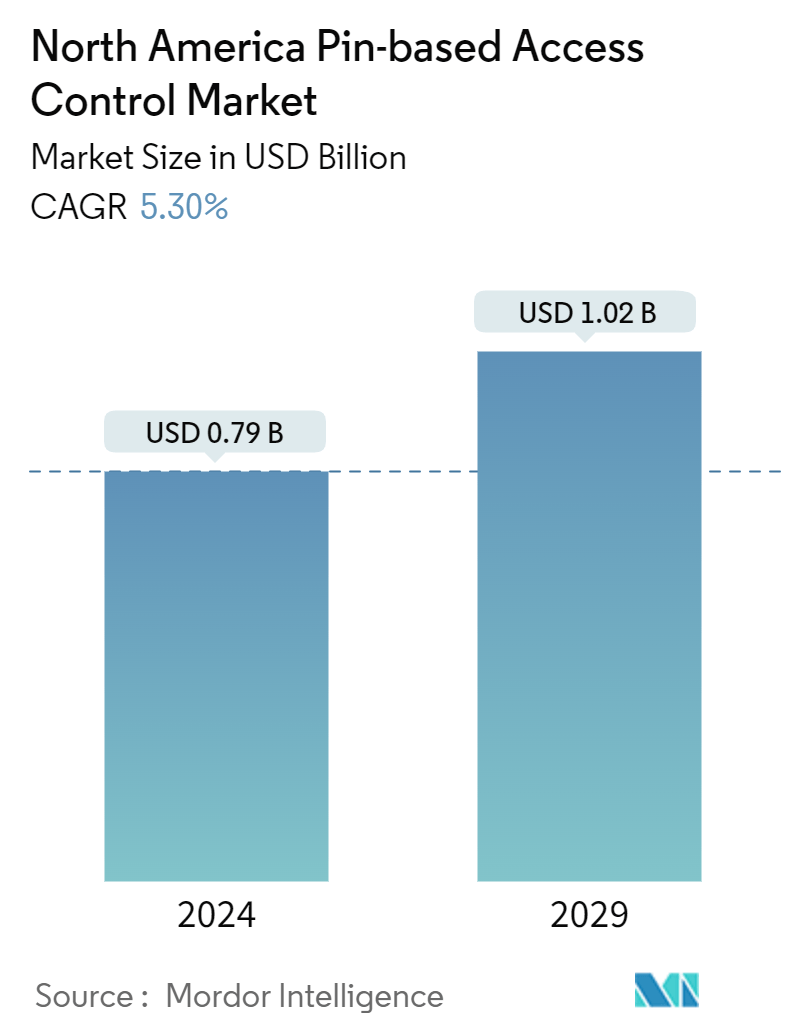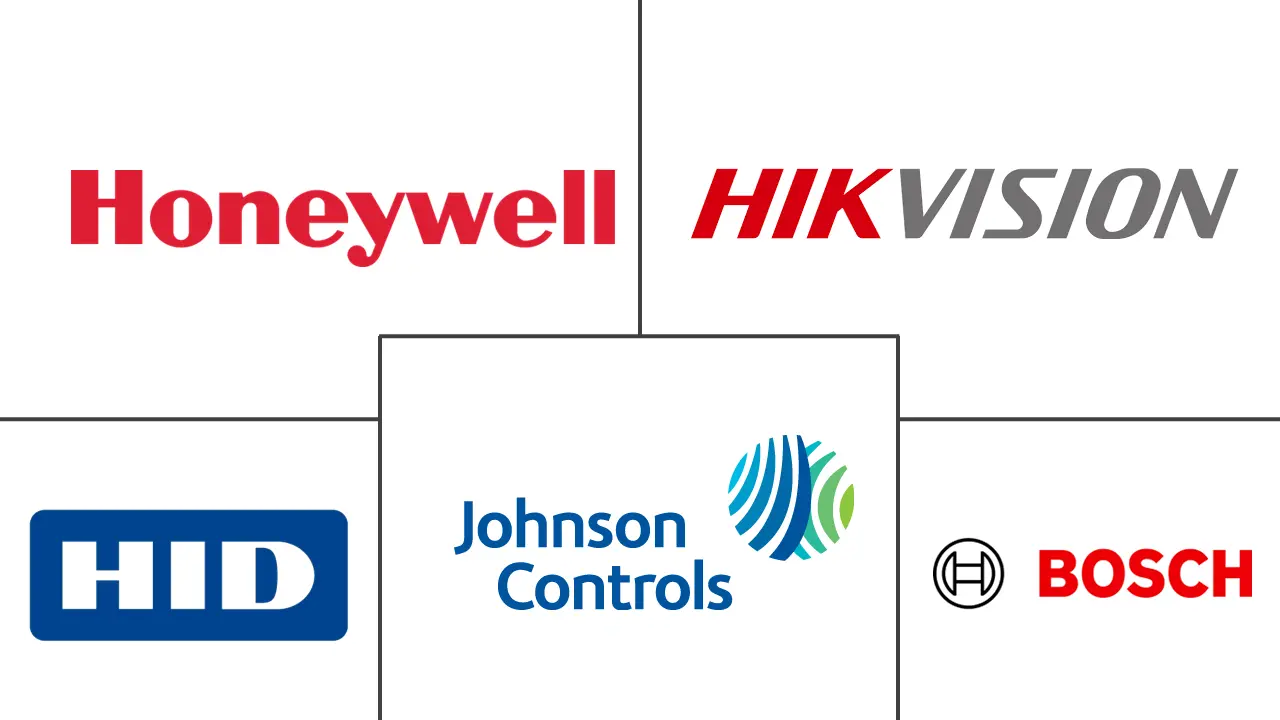Market Size of North America Pin-based Access Control Industry

| Study Period | 2019 - 2029 |
| Base Year For Estimation | 2023 |
| Market Size (2024) | USD 0.79 Billion |
| Market Size (2029) | USD 1.02 Billion |
| CAGR (2024 - 2029) | 5.30 % |
| Market Concentration | Low |
Major Players
*Disclaimer: Major Players sorted in no particular order |
North America Pin-based Access Control Market Analysis
The North America Pin-based Access Control Market size is estimated at USD 0.79 billion in 2024, and is expected to reach USD 1.02 billion by 2029, growing at a CAGR of 5.30% during the forecast period (2024-2029).
- The increasing privacy and security concerns and the increasing theft of crucial data and information contribute to the market's growth. The number of terrorist activity and rising crime rates have increased in the region in the past few years. This has heightened concerns about the safety of people, assets, and processes, resulting in severe damage to infrastructure and the loss of multiple lives.
- Furthermore, pin-based access controls are easily scalable, making them suitable for SMEs who want to secure their data without spending extra money. Several pin-based access control systems can track who accessed a particular area along with time. These systems are often compatible with the existing infrastructure, making them a convenient choice to integrate into older security systems.
- The number of burglaries and crimes has increased worldwide in the past few years. This has heightened concerns about the safety of people, assets, and processes, resulting in severe damage to infrastructure and the loss of multiple lives. According to The Council on Criminal Justice (CCJ), motor vehicle theft, a crime that began surging in the summer of 2020, maintained its upward trend through 2023, with a 29% increase in reported thefts compared to 2022 in the United States.
- Meanwhile, residential burglary rates across cities in the United States were 26% lower in 2023 compared to 2019, and they saw a 3% decline in 2022, marking a reduction of 1,052 incidents. Residential burglary dropped by 4% in the first half of 2023 and by 1% in the latter half compared to the same periods in 2022. There are many technologies that can help in decreasing the crime rate. One of them is pin-based access control.
- The necessity for strict identity verification due to the accelerating adoption of transactional technologies is increasing the demand for biometrics access controls, which consumers prefer over traditional pin-based access control, hindering the market's growth. The integration of other access control systems, such as biometrics and facial recognition, is expected to restrict the market's growth. The ongoing development in technology and growing preferences for contactless access control are expected to hinder the market's growth.
- Rising inflation rates have increased the cost of goods and services, including pin-based access control systems. Higher costs lead to reduced purchasing power for consumers and businesses, slowing down the market's growth. Further, the ongoing war between Russia and Ukraine has disrupted the global supply chain, particularly affecting the availability and cost of electronic components and raw materials used in pin-based access control systems. This is leading to delays in production and increased costs for manufacturers.
North America Pin-based Access Control Industry Segmentation
Access control systems are an essential element of security that governs who is allowed access to specific information, applications, and data sources. It safeguards sensitive information, such as information of customers and intellectual property, from being stolen by malicious actors or unauthorized users. Pin-based access control is a popular method of authenticating consumer identity more efficiently.
The study tracks the revenue acquired through the sale of pin-based access control by various players in North America. The study also tracks the key market parameters, underlying growth influencers, and major vendors operating in the industry, which supports the market estimations and growth rates during the forecast period. The study further analyses the overall impact of aftereffects of the COVID-19 pandemic and other macroeconomic factors on the market. The report’s scope encompasses market sizing and forecasts for the various market segments.
The North American pin-based access control market is segmented by component (hardware and software), organization size (SMEs and large enterprises), end-user industry (banking and financial services, government services, retail, IT and telecommunications, healthcare, power and utilities, residential, and other end-user industries), and country (United States and Canada). The market sizes and forecasts are provided in terms of value (USD) for all the above segments.
| By Component | |
| Hardware | |
| Software |
| By Organization Size | |
| SMEs | |
| Large Enterprises |
| By End-user Industry | |
| Banking and Financial Services | |
| Government Services | |
| Retail | |
| IT and Telecommunications | |
| Healthcare | |
| Power and Utilities | |
| Residential | |
| Other End-user Industries |
| By Country | |
| United States | |
| Canada |
North America Pin-based Access Control Market Size Summary
The North American pin-based access control market is experiencing growth driven by increasing concerns over privacy and security, as well as the rising incidence of theft and crime. These systems are becoming essential for safeguarding people, assets, and processes, particularly in commercial settings such as financial institutions, enterprises, and retail spaces. The scalability and compatibility of pin-based access control systems with existing infrastructure make them an attractive option for small and medium enterprises looking to enhance security without significant financial investment. The integration of these systems with mobile applications and advanced technologies like Wi-Fi and Bluetooth is further propelling their adoption, offering cost-effective and convenient solutions for access management.
Despite the positive growth trajectory, the market faces challenges from the rising preference for biometric and contactless access control systems, which are seen as more advanced alternatives. Economic factors such as inflation and global supply chain disruptions, particularly due to geopolitical tensions, are also impacting the market by increasing costs and delaying production. However, the ongoing development of innovative access control solutions and the strategic efforts by key players to expand their product offerings and market presence are expected to sustain the market's growth. The fragmented nature of the market, with numerous players like Johnson Controls, Salto Systems, and HID Global Corporation, indicates a competitive landscape where companies are continuously striving to enhance their offerings and capture a larger market share.
North America Pin-based Access Control Market Size - Table of Contents
-
1. MARKET INSIGHTS
-
1.1 Market Overview
-
1.2 Industry Attractiveness - Porter's Five Forces Analysis
-
1.2.1 Bargaining Power of Suppliers
-
1.2.2 Bargaining Power of Consumers
-
1.2.3 Threat of New Entrants
-
1.2.4 Threat of Substitutes
-
1.2.5 Intensity of Competitive Rivalry
-
-
1.3 The Impact of the Aftereffects of the COVID-19 Pandemic and Macroeconomic Factors on the Market
-
-
2. MARKET SEGMENTATION
-
2.1 By Component
-
2.1.1 Hardware
-
2.1.2 Software
-
-
2.2 By Organization Size
-
2.2.1 SMEs
-
2.2.2 Large Enterprises
-
-
2.3 By End-user Industry
-
2.3.1 Banking and Financial Services
-
2.3.2 Government Services
-
2.3.3 Retail
-
2.3.4 IT and Telecommunications
-
2.3.5 Healthcare
-
2.3.6 Power and Utilities
-
2.3.7 Residential
-
2.3.8 Other End-user Industries
-
-
2.4 By Country
-
2.4.1 United States
-
2.4.2 Canada
-
-
North America Pin-based Access Control Market Size FAQs
How big is the North America Pin-based Access Control Market?
The North America Pin-based Access Control Market size is expected to reach USD 0.79 billion in 2024 and grow at a CAGR of 5.30% to reach USD 1.02 billion by 2029.
What is the current North America Pin-based Access Control Market size?
In 2024, the North America Pin-based Access Control Market size is expected to reach USD 0.79 billion.

